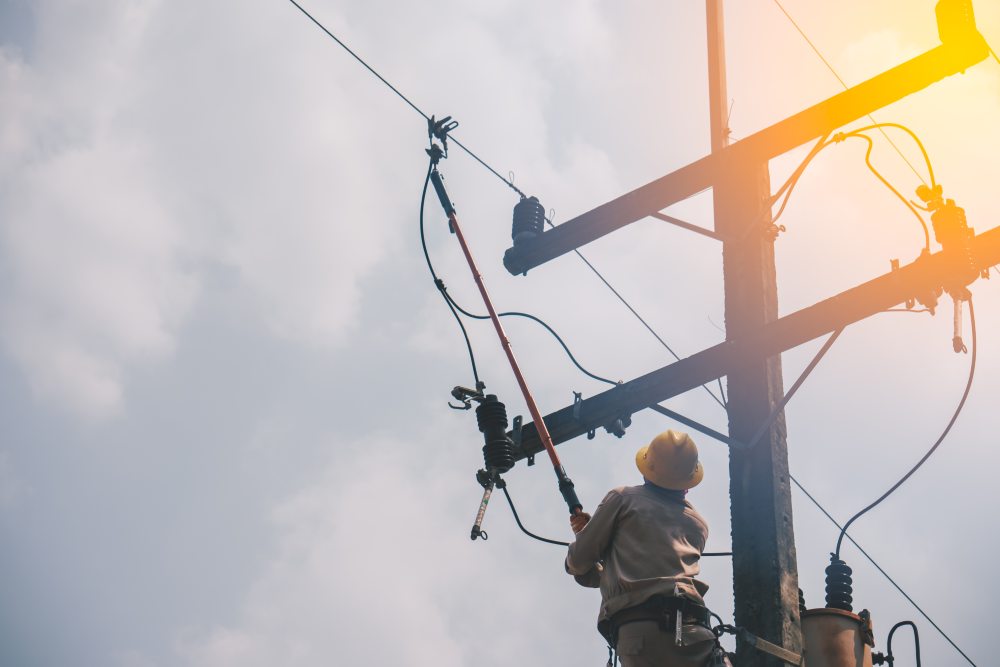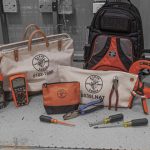The job of a lineman is a hazardous job as linemen work on high voltage equipment every day. While there are instances when the electrical equipment linemen work on is de-energized, there are many cases in which they perform live-line work and maintenance, also known as hotline work. Live-line maintenance is done to avoid turning off power which is inconvenient to customers and can have high economic costs. In order for linemen to stay safe while working on live electrical equipment, they need to use the proper tools that can protect them from electrical current.
There are a wide variety of hot line lineman tools available that are built to protect linemen from electrical currents as they work. Hot line tools and equipment are insulated to prevent linemen from coming into direct contact with the electrical equipment and current. Many of the tools are fixed onto long insulated poles known as hot sticks that also allow linemen to work on electrical equipment from a safe distance. It is important for linemen to make sure that they use quality hot line tools to keep themselves protected.
Give Divergent Alliance a call at (847) 531-0559 or submit a contact form for pricing. We offer fast-shipping across the United States.
In this guide, we will cover the various types of hot line tools used by linemen when performing hotline work. Divergent Alliance is a supplier of lineman tools in the Chicago area and we have hot sticks and other hot line tools available from major manufacturers like Chance Lineman Grade Tools, Hastings Fiberglass, Salisbury. Contact Divergent Alliance if you need quality, hot line tools that will get the job done while keeping you protected.
Why Hot Line Tools are Important
Electrical equipment such as powerlines and transformers have a dangerous amount of electrical current running through them which is why lineman safety is of utmost importance. There are certain repairs and maintenance duties that need to be done while the electrical system and circuits are live. Even when the circuits are de-energized, there is always a possibility they can become re-energized. Therefore, it is important for lineman to always take caution and use hot line tools when working on high-voltage electrical circuits.
The Evolution of Hot Line Tools
The use of hot line tools to work on energized lines goes as far back as 1913 when tools fitted to disconnect sticks were used to safely open disconnect switches. It was soon understood that hot line tools could be used for more than just opening switches on energized lines. The first hot line tools were homemade and in 1916, a tool known as an “electrical hook” was first used in Atlanta, GA for tapping energized circuits. The electrical hook needed to be attached to a hot stick to be used safely and this concept of using a hot stick allowed for the development of additional tools such as clamps that could be used to work on live lines.
The Tips Tool Company was the first to manufacture hot line tools in 1918 including hot line clamps, grounding clamps, and clamp sticks. They then introduced more tools such as the hot line tree trimmer and wire tong saddles, perpetuating the idea that a universal hot stick can be used with interchangeable tool heads. The A.B. Chance Company purchased Tips Tool Company in 1937 and they continued to research and develop hot line tools as they recognized the need to be able to work safely on live powerlines without disrupting power to homes. Out of this research and development came the practice of hot line maintenance. By the 1950s, A.B Chance Company was manufacturing hot line tools that allowed linemen to safely work on 345kv powerlines.
The first hot sticks were made from various types of wood, with Sitka spruce becoming the most popular because it is light weight and has excellent electrical properties. The wood was first insulated with a shellac coating and eventually synthetic resins were used. In the mid-1940s, Chance Laboratories began using plastic coating over the wood to insulate hot sticks. Today, most hot sticks are made of fiberglass which provides electric insulation and is very light weight.
The weight issue when it comes to hot line tools is extremely important for reducing the fatigue of linemen. Not only have hot sticks become stronger and more light weight, but the tools fixed to the ends of the hot sticks have become lighter as well. In the late 1940s, A.B. Chance Company introduced light weight, heat-treated aluminum alloy heads that were also easy to operate. Ease of use and the light weight of the tools to reduce fatigue were crucial developments for the safety of linemen. Tools used as hot stick attachments are still largely made of aluminum today.
Types of Hot Line Tools
There are a variety of tools that linemen use when working on live powerlines including wrenches, disconnect tools, wire claws, vice grips, pruning saws, cleaning brushes, ice removers, clamps, screwdrivers, hooks, knives, fuse pullers, insulators, and more. The one thing all these powerline tools have in common is that they are often attached to an insulated hot stick. Hot sticks are the most important tools when it comes to hotline maintenance and they can be fitted with a wide variety of hot stick attachments to tackle different types of maintenance.
Hot sticks are insulated, fiberglass poles that insulate linemen from electric shock and allow them to work on live electrical equipment from a physical distance. The distance that linemen can put between themselves and the live electrical equipment helps protect them from burns if an electric arc occurs. There are several types of hot sticks that come in fixed lengths, and there are telescopic hot sticks available as well that can extend.
The following are the different types of hot line sticks:
- Shotgun sticks: Shotgun sticks are hot sticks that collapse for storage, often by folding in the middle. These hot sticks also feature a sliding hand grip that allows the lineman to open and close a hook at the end of the stick and grip a clamp. There are fixed length and telescopic shotgun sticks available.
- Measuring sticks: Measuring hot sticks are used to measure vertical heights of overhead powerlines and structures. Many of these measuring sticks are telescopic and spring loaded to reach vertical heights and the readings are at eye level. There are also combination measuring sticks available that can open and close switches, line fuses, and disconnects.
- Telescopic sticks: Telescopic hot sticks are extendable and retractable to reach varying heights. Most varieties of hot sticks are available as telescopic sticks.
- Hot pole tongs: Hot pole tongs are tongs with hot stick handles that can be locked in multiple hinge positions around wood poles. These tongs can hinge securely around poles of various diameters and they often have steel teeth on the tongs for better grip.
Hot Sticks and Other Lineman Tools from Divergent Alliance
The development of the hot stick was crucial for protecting linemen while they perform hotline maintenance. Hot sticks allow linemen to work safely on live electrical equipment while avoiding costly and inconvenient power shutdowns.
If you are in need of hot sticks and other lineman tools in the Chicago, IL area, contact Divergent Alliance. We are a supplier of lineman tools and equipment from the top manufacturers in the industry. Contact Divergent Alliance or give us a call at (847) 531-0559 to learn more.
GET YOUR CATALOG TODAY
Looking to learn more about the lineman tools and equipment?
Download their catalog and send us your questions and requests.






